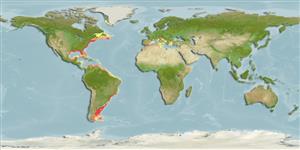| Native range | All suitable habitat | Point map | Year 2100 |

|
| This map was computer-generated and has not yet been reviewed. |
| Etrumeus sadina AquaMaps Data sources: GBIF OBIS |
Issue
Some information are attached to E. jacksoniensis Macleay, 1878, a synonym of Etrumeus (Ref. 93002).
Length at first maturity
Lm 16.4 range ? - ? cm
Human uses
Fisheries: highly commercial
Phylogenetic diversity index
(Ref. 82805)
PD50 = 0.5098 many relatives (e.g. carps) 0.5 - 2.0 few relatives (e.g. lungfishes)
Trophic Level
(Ref. 69278)
3.6 ±0.2 se; Based on diet studies.
Resilience
(Ref. 69278)
Medium, minimum population doubling time 1.4 - 4.4 years (K=0.13-0.8; tm=1.7; tmax=5)